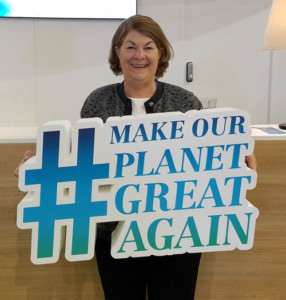Notes from Bonn: Concluding notes on COP 23

by Andrea Tuttle, PFT Board Chair
Friday, November 17, 2017
Today, Friday, marks the end of this intense, two-week meeting of people from all over the world. I’m always in awe every time I take in the diversity of life experiences and viewpoints here.
At a literal level, the planet truly does provide the basics of life! That reality underlies the hundreds of speeches, meetings, diplomatic interventions, arguments, presentations, panels, and debates held in these sprawling buildings.
Climate negotiations are not for the faint of heart! This stuff is hard! Weaning the world from fossil fuels that have built societies and underpin deep vested interests means some parties still cling hard to the status quo. Their economies depend on it, their people demand better lives, and fossil fuels are an easy path.
But something’s different this year – the earth is talking back. Almost every speaker reminds us of this year’s destruction from hurricanes, droughts, wildfires, floods, and extreme heat. These are hitting faster and bigger than the models even predicted.
The decisions from this year’s meeting aren’t dramatic, but they are necessary. The goals were to specify how the Paris Agreement will operate: How will countries report progress towards their pledges for emission reductions, and how will those be verified? How will flows of finance to help developing countries be recorded and tracked? What role should the UN have in setting rules for carbon markets between countries? Lists of options have been developed, and mid-year sessions will tee-up further decisions for 2020.
But take heart, it’s not all talk! Real emission reductions are happening! Real gigawatts of renewable energy are being generated from China to Morocco, from India to Kenya and beyond. States, provinces, cities and regions are taking ambitious steps on their own, improving energy efficiency, building charging stations for electric cars, cleaning their grids, changing out old heating and cooling systems, installing LED bulbs, upgrading their public transit and greening their urban spaces. Major businesses see huge opportunities in investing in the global low-carbon revolution – it is a growth industry! The private sector is here and on board, anxious to be an engine of change.
The big white balloon tent of the US Climate Action Pavilion was a huge hit. Sponsored privately by Mayor Bloomberg and many contributors, and filled with enthusiastic talks from Governors, legislators, state agencies and NGOs sent a huge signal that at the local level the “US is Still In!” The ambitious commitments and actions sent a welcome message to the rest of the delegates that we really are still part of the effort.
It’s worth scanning the UNFCCC COP 23 website for a deeper flavor of the negotiations and the wealth of topics covered. Decision documents can be found here.
And there’s a fabulous education from the side events: On-demand webcasts of many of the sessions are available online. Everything from global climate models, soils and agriculture, the role of women in adaptation, block-chain tracking of emission reductions, solar and battery driven maritime transport, virtual reality goggles to experience arctic sea-beds, economic analyses of the renewable energy revolution – and, of course, the key role of forests for achieving 1/3 of the necessary emission reductions for the world – much of it is online.
This year, Forests and Global Landscapes will have their own entirely separate conference in Bonn in December.
The world is making a move on the climate challenge. It’s truly a heavy lift — but there are lots of good reasons for optimism!
Tschüss, bis später, auf Wiedersehen and Bula Vinaka from Bonn!
Andrea
